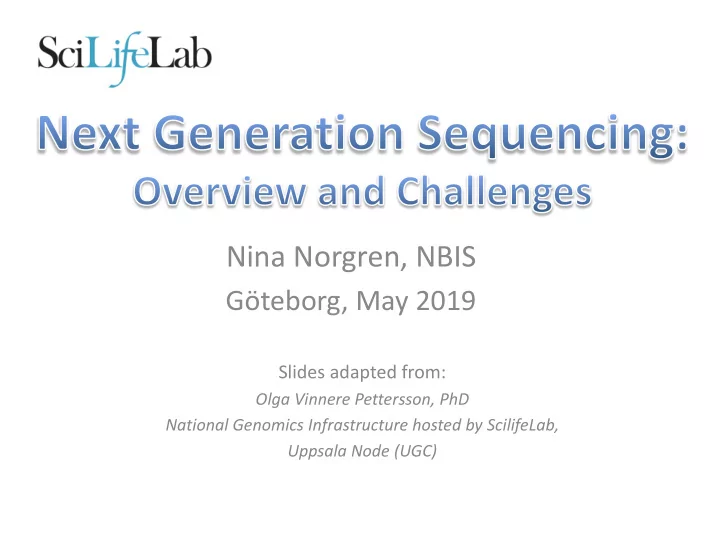

Nina Norgren, NBIS Göteborg, May 2019 Slides adapted from: Olga Vinnere Pettersson, PhD National Genomics Infrastructure hosted by ScilifeLab, Uppsala Node (UGC)
Project handling at NGI
How does a project go? Project request
Short History of NGS
Once upon a time… • Fredrik Sanger and Alan Coulson Chain Termination Sequencing (1977) Nobel prize 1980 Principle: SYNTHESIS of DNA is randomly TERMINATED at different points Separation of fragments that are 1 nucleotide different in size ! Lack of OH- group at 3’ position of deoxyribose 1 molecule sequenced at a time = 1 read Capillary sequencer: 384 reads per run
2006: NGS was born Thousands of molecules sequenced in parallel 1 mln reads sequenced per run Roche 454 GS FLX
Since the beginning of Genomics: First genome: virus X 174 - 5 368 bp (1977) • • First organism: Haemophilus influenzae - 1.5 Mb (1995) • First eukaryote: Saccharomyces cerevisiae - 12.4 Mb (1996) • First multicellular organism: Cenorhabditis elegans - 100 MB (1998-2002) • First plant: Arabidopsis thaliana - 157 Mb (2000)
… prices go down Human genome sequencing: 2004: Genome of Craig Wenter costs 70 mln $ • Sanger’s sequencing 2007: Genome of James Watson costs 2 mln $ • 454 pyrosequencing 2014: Ultimate goal: 1000 $ / individual 2016: Illumina Xten: Almost there! (1200 $) 2017: NovaSeq : ” Hold my beer …” (100 $)
… paradigm changes • From single genes to complete genomes • From single transcripts to whole transcriptomes • From single organisms to complex metagenomic pools • From model organisms to the species you are studying • Personal genome = personalized medicine
… scientific value diminishes IF 31.6 IF 2.9
Current Technologies
Read length 1000000 300000 100000 50000 10000 110 600 1 2 3 4 5 6 7
Illumina Instrument Yield and run time Read Error Error Length rate type 120 Gb – 600 Gb HiSeq2500 110x110 0.1% Subst 27h or standard run (250x250) 540 Mb – 15 Gb MiSeq up to 0.1% Subst (4 – 48 hours) 350x350 “ “ HiSeqXten 800 Gb - 1.8 Tb 150x150 (3 days) 250 Gb – 3 Tb “ “ NovaSeq 150x150 6000 Main applications • Whole genome, exome and targeted reseq • Transcriptome analyses • Methylome and ChiPSeq • Rapid targeted resequencing (MiSeq) • Human genome seq (Xten)
Illumina : bridge amplification https://www.youtube.com/watch?v=fCd6B5HRaZ8
NovaSeq 6000 • NGI has five instruments • Flexible and scalable using multiple flow cell types • Quick and easy operation using RFID labeled reagent cassettes • Onboard clustering and automatic washing minimises hands on time during runs • 2 color chemistry T= Green C= Red A= Green / Red G=no signal
PacBio Instrument Yield/cell Read Length Error rate Error type and run time 250 Mb – 1.8 Gb 250 bp – 60 kb RSII 15 % Indels, random (single pass) 30 - 600 min (78 kb) 0.0001% (circular consensus) 250 bp – 80 kb SEQUEL 2-14 Gb as RSII Indels, 30-2400 min (160 kb) random Single-Molecule, Real-Time DNA sequencing
PacBio: SMRT - technology SMRT = Single Molecule Real Time
SMRT sequencing: common misconceptions High error rate? Irrelevant, because errors are random Depending on coverage Examples: • 8 Mb genome, 8 SNPs detected • 65 kb construct: 100% correct sequence • Detection of low frequency mutations High price? Bioinfo-time to assemble short reads Not for small genomes Bioinfo-time to assemble Better assembly quality long reads Single-molecule reads without PCR-bias
Oxford Nanopore Flow Cells Yield - run time run in parallel 1 – 10 Gb / cell MinION (1) 5 – 50 Gb / 5 cells GridION (5) 20 – 100 Gb / cell PromethION (12 - 24 - 48) Reads up to 6-8 Gb 10-15% error rate Life time 5 days Longest reads: beyond 1 Mb
10x Genomics (Chromium) Fragment length: 50 kb – 100+ Kb
NGS Applications
NGS/MPS applications • Whole genome sequencing: – De novo sequencing – Re-sequencing • Transcriptome sequencing: – mRNA-se q – miRNA – Isoform discovery • Target re-sequencing – Exome – Large portions of a genome – Gene panels – Amplicons
Whole genome sequencing: de novo De novo: used to assemble a genome without previous reference Conventional strategy (Golden Standard): Illumina 50x sequencing on HiSeqX or NovaSeq, several insert sizes (+ Mate Pairs) Current recommendation* (Platinum genome): 100x PacBio (ONT) only + Hi-C (coverage depends on heterozygocity) Plus RNA-seq data for annotation * 2019-02-05
De novo – do it with long reads! Beware: up to 80% of novel structural variants can be missing from short-read data. Sequence fewer genomes, but with long reads
Transcriptome sequencing (RNA-seq) TOTAL RNA mRNA Splice isoforms • Dif.ex. • miRNA Non-codingRNA Annotation • Transcriptional regulation
RNA-seq experimental setup • mRNA only: any kit • mRNA and miRNA: only specialized kits • Always use DNase! • RIN value above 8. • CONTROL vs experimental conditions • Biological replicates: 4 strongly recommended
RNA-seq with long reads PacBio Iso-seq : full-length transcriptome seq Coming soon: direct RNA-seq on ONT
Main types of equipment & applications Illumina HiSeq Ion S5 XL NextSeq, HiSeqX10, MiSeq, PacBio RSII MiniSeq, NovaSeq SEQUEL Short paired reads Short single-end reads Ultra-long reads HIGH throughput FAST throughput FAST throughput Human WGS mRNA and miRNA Long amplicons Re-sequencing 30x Exome Re-sequencing mRNA and miRNA ChIP-seq De novo sequencing De novo transcriptome Short amplicons Novel isoform discovery Exome Gene panels Fusion transcript analysis ChIP-seq Clinical samples Resolving haplotypes Short amplicons Clinical samples Methylation
BIG DATA 2025 projection : data storage needs 1 petabyte = 10 15 bytes 1 exabyte = 10 18 bytes 2-40 exabytes/year 1-2 exabytes/year 1 exabyte/year Large Hadron Collider 42 petabytes/year 1-17 petabytes/year
Thanks for listening! Questions? support@ngisweden.se
Recommend
More recommend